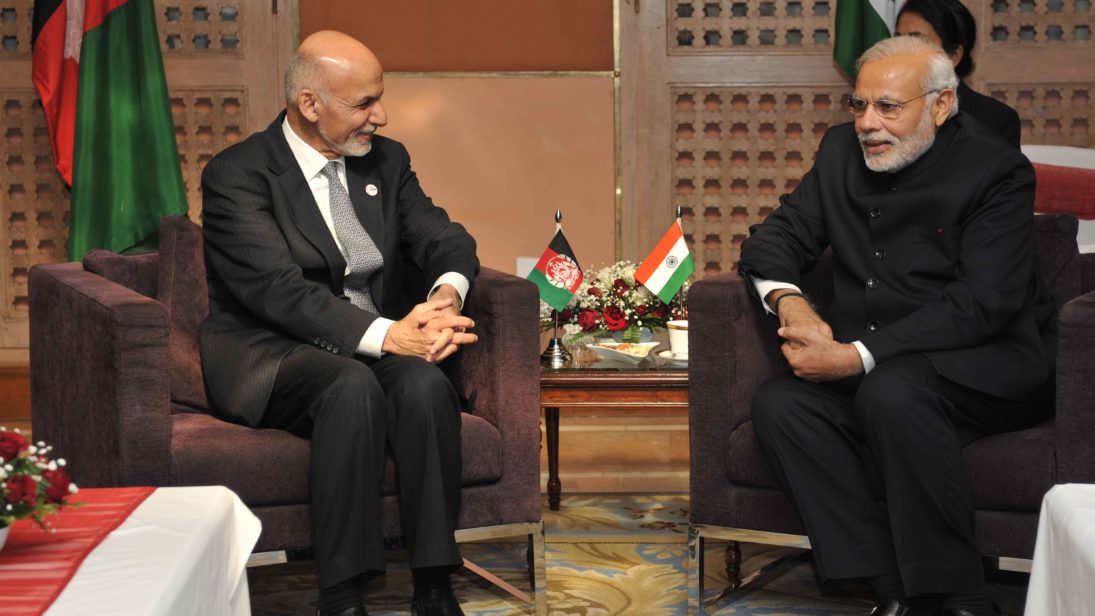
India has been an important player in the reconstruction and rehabilitation of conflict-ridden Afghanistan, which continues to rile under an uncertain security scenario amidst the international drawdown. However, despite being one of the largest bilateral aid donors to Afghanistan in the civilian sector, there seems to be no consensus in New Delhi on what could impart greater strategic heft to its role there. Despite New Delhi’s unwavering support for a stable and secure Afghanistan, the specifics of the strategic partnership between India and Afghanistan have often been found wanting.
Given India’s adversarial relationship with China and Pakistan, Kabul’s recent ploys with Beijing and Islamabad have been closely watched in New Delhi. After coming to power in September 2014, President Ashraf Ghani initially made efforts to reinvigorate relations with Islamabad and Beijing at the cost of undermining India-Afghanistan ties. Ghani undertook his first state visit to China in October 2014, where the emphasis was on cooperation in the strategic, economic, and technical domains. Immediately after, Ghani visited Pakistan, where he met with the military and civilian authorities to enhance security cooperation—with some emphasis on improvement of economic ties between the two countries. Moreover, with the new government’s interest in rekindling talks with the Taliban, efforts were geared towards nudging China and Pakistan to do more by bringing the Taliban to the negotiating table. Following Track II talks in Doha, Dubai, Oslo, and Urumqi, the Murree talks were the first direct talks between a Taliban delegation and representatives of the Afghan government and High Peace Council, with China and the United States as observers and Pakistan as guarantor. However, after the announcement of Taliban leader Mullah Omar’s death, the Taliban called off the second round of talks. As the number of attacks in Afghanistan increased, questions were raised on Pakistan’s ability and willingness to rein in the violent extremism that was paralyzing Afghanistan’s peace and security. Pakistan’s claims of “some influence” over the Taliban culminated in a deteriorating state of Kabul-Islamabad dynamics.
Meanwhile, Ghani began to turn over a new leaf in his approach to India. Since CEO Abdullah Abdullah’s visit in February 2015, followed by Ghani’s trip in April, ties between the two countries have moved ahead in a favorable manner. The priority that is accorded to the relationship can be observed through events like the high profile visits by Prime Minister Narendra Modi to Afghanistan in December 2015 and June 2016. During his visits, Narendra Modi inaugurated two highly visible India-funded projects, namely the Afghan Parliament and the Afghanistan-India Friendship Dam. In May 2016, India and Afghanistan also signed a trilateral transit and trade corridor agreement, or the Chabahar Port Agreement, along with Iran. Additionally, an initial investment agreement has been reached for the Turkmenistan-Afghanistan-Pakistan-India (TAPI) pipeline, which is supposed to be completed by December 2019. Recently, the Indian government has also pledged another $25 million in aid to Afghanistan towards the implementation of micro-development projects.
Despite India being perceived as a sustainable and reliable donor for Afghanistan’s reconstruction, opinions in India regarding what lies ahead in the relationship differ. While New Delhi’s policy of non-interference can be seen as a positive that has led to general goodwill towards India in Afghanistan, India’s absence from the political dialogue for the future of Afghanistan makes it a secondary player in terms of shaping things to come. New Delhi’s aversion to talks with the Taliban has often been read as a principle cast in stone.
However, Beijing’s inclusion in the Quadrilateral Coordination Group (QCG), which also includes Afghanistan, Pakistan, and the United States and hopes to bring meaningful talks with the Taliban, portends the shifting sand of external players’ involvement in Afghanistan. In this context, creating various fora that include space for India have been proposed, such as the QCG along with India, Iran, and the Central Asian states or the QCG members along with India, Iran, and Russia. A forum made up of India, Russia, China, the European Union, Japan, and the United States has been identified as integral to guide the economic aspects of Afghanistan’s transformation.
One of the most contentious yet critical elements of the India-Afghanistan relationship remains the scope of defense cooperation. Recently, India transferred three Mi-25 attack helicopters to Kabul. In addition, the India is to provide training to Afghan security institutions to enhance the latter’s limited capabilities. With India’s large-scale projects already completed or nearing completion, India’s soft power approach has hit a ceiling, thus necessitating a ‘smart power’ approach. India must scale up its military equipment transfers to Afghanistan with the final goal of strengthening the Afghan government’s authority and legitimacy. In fact, at the United Nations Security Council debate on the UN Assistance Mission in Afghanistan recently, India’s Permanent Representative to the UN Syed Akbaruddin said: “Afghanistan has our full support for strengthening its defense capabilities.”
Additionally, the potential of India-Afghanistan trade has been seriously constrained by Pakistan’s refusal to allow the use of its territory for transit. In this context, the Chabahar Port Agreement, which seeks to circumvent the Pakistani land barrier, is significant. However, India’s desire for inclusion in the Afghanistan-Pakistan Transit Trade Agreement (APTTA) has received stimulus with the agreement between Kabul and Islamabad to revise APPTA, which will allow Afghan trucks to carry goods up to Wagah, and unlike the present state of affairs, to carry goods from India and Pakistan back to Afghanistan. Though this is conditioned on Pakistan gaining access to Central Asia through Tajikistan. India has shown its readiness to join APTTA during the Heart of Asia meeting, an inclusion which will ensure cost effective and mutually beneficial transit of goods between Afghanistan and India via Pakistan. However, the revision of the Agreement awaits fruition.
Afghanistan, recipient of the largest program of Indian assistance, has also been a learning curve for donor India. In the realm of development assistance, India’s dedicated involvement and understanding of the priorities of a recipient country like Afghanistan has been commendable. However, issues like cost overruns, inadequate allocations, and overall delays have to be mitigated to amplify the impact of India’s development assistance projects. This will serve to strengthen the favorable image that Afghans have of India, finally culminating in a narrative that supports India’s presence.
In the speech following the inauguration of the Afghanistan-India Friendship Dam, Prime Minister Modi stated that “India will not forget or turn away.” This statement clearly implies the priority that New Delhi accords to the India-Afghanistan strategic partnership and emphasizes that it will stay the course. However, in the midst of uncertainties and the crowded theater that Afghanistan has become for a number of stakeholders, New Delhi faces the challenge of figuring out what it wants in Afghanistan and what it is willing to do.
***



